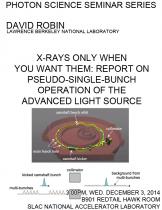Speaker: David Robin, Lawrence Berkeley National Laboratory
Program Description
Laser pump – x-ray probe experiments require control over the x-ray pulse pattern and timing. Such stroboscopic pump-probe or time-of-flight experiments often demand x-ray pulses with high peak power, but also require low to medium repetition rates, from single shot up to 1 Mhz. These repetition rates are well below the natural repetition rate of synchrotron sources where the temporal spacing between x-ray pulses is typically on the order of just a few nanoseconds. Pseudo-single-bunch Kick-and-cancel (PSB-KAC) is a new operational mode at the Advanced Light Source (ALS) that provides full timing and repetition rate control for single x-ray pulses while being transparent to other users of synchrotron radiation. In PSB-KAC operation, a single electron bunch is displaced transversely from the other electron bunches using a short-pulse kicker magnet. Experiments that require light emitted only from a single bunch can stop the light emitted from the other bunches using a collimator. We present the concept and results of pseudo-single-bunch (PSB) operation. We report the first use of pseudo-single-bunch mode at the Advanced Light Source in picosecond time resolved x-ray absorption experiments on solutions and solids. In this mode, suppressing undesired x-ray pulses considerably reduces detector noise and improves signal to noise in time-resolved experiments. In addition, dose induced sample damage is considerably reduced, easing experimental setup and allowing the investigation of less robust samples. We also demonstrate single shot x-ray exposures of a streak camera detector using a conventional not-gated charge-coupled device (CCD) camera.





